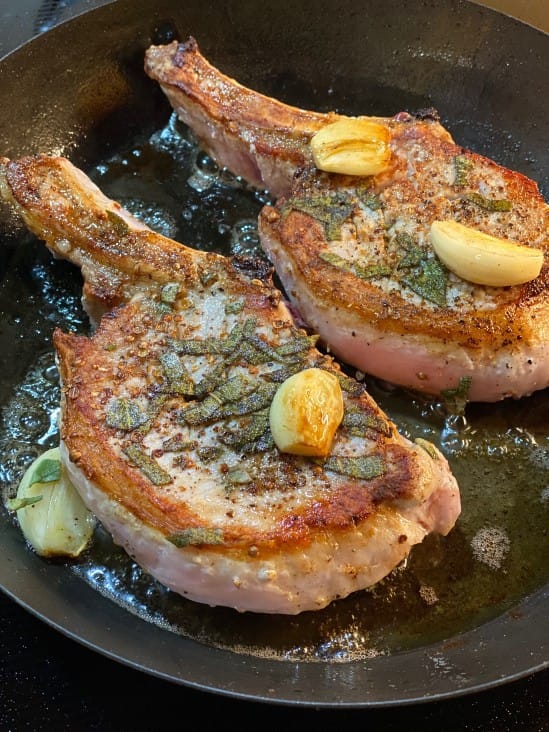Recipe: Pan-seared Pork Chops With Garlic, Sage And Coriander Seed
To master this dish, there are three elements to consider: the quality of meat, the pan, and the technique.

To master this dish, there are three elements to consider: the quality of meat, the pan, and the technique.

Serves 2
This dish leans equally on three things: the quality of the pork, the quality of the pan, and mastering the technique. Let me walk you through each of them so you end up with a juicy, delicious entrée with very little time or fuss.
For the pork, you will want to ask your butcher or meat purveyor for a bone-in, heritage breed (Berkshire pork is a great breed) that has been raised on pasture. You are likely to get a humanely raised animal that has done some of its own foraging, resulting in a fully flavored and tender pork chop.
The next important element is the pan. I use a black steel pan vs. cast iron mainly because black steel is lighter and subsequently quite a lot easier on my wrists. Also, the black steel is thinner and heats up very quickly and cools down faster than cast iron, which is helpful for this technique. If you have neither type of pan, then stainless steel with a heavy bottom will work fine.
Lastly, the technique: In order to get a great looking and tasting crust, I lightly score both sides of the chops with the tip of a knife in a cross hatched pattern — no more than an eighth of an inch deep. Then I generously season both sides with sea salt, pepper, crushed coriander seed and chopped fresh sage. I refrigerate the pork and let it sit on this dry marinade for a couple of hours.
The salt will gently draw just a little bit of surface juices from the pork and when this hits the pre-heated pan (heat the pan over medium high heat for 2 minutes, then add the olive oil and wait until it shimmers) the pork’s juices will caramelize quickly and create the seared crust you want. Turn the chops over and turn the heat way down and cook the chops low and slow until they are at 135 degrees internal temperature. Add the halved garlic cloves right after the first side is nicely seared and let the slow and low heat cook them until they are tender. Remove the chops from the pan to rest for 5 minutes. The internal temperature will continue to climb up to around 140 degrees off the heat. I like to deglaze the cooking pan with a little dry Marsala and swirl in a knob of butter to pick up all the browned bits left behind. Spoon this pan sauce over the pork, making sure the collect any resting juices and incorporate them back into the sauce.
Ingredients:
2 heritage breed pork chops on the bone — each about 1 ½ inches thick
2 cloves garlic, peeled and sliced in half
1 healthy sprig of fresh sage, chopped
1 teaspoon crushed coriander seed
Sea salt to taste — about 1 teaspoon divided between both sides of the chops
A few grinds of black pepper
2 Tablespoons olive oil for searing
3 Tablespoons of dry marsala
1 Tablespoon of butter for finishing the sauce